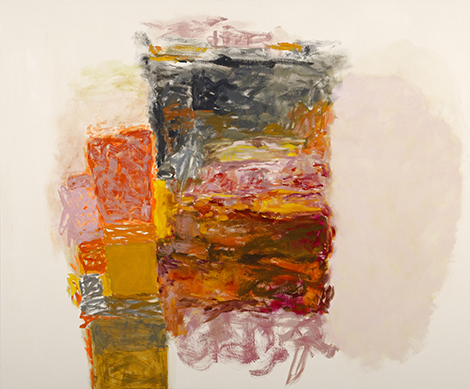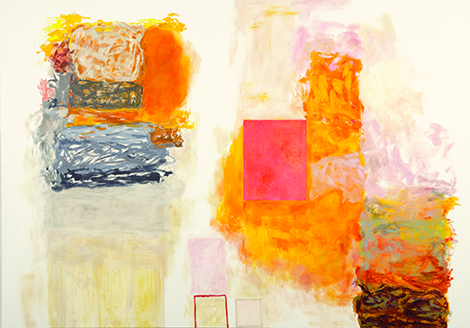Mark making is the Cuban born, Atlanta based artist Rocio Rodriguez’ mode of operation. Continuing in the tradition of Abstract Expressionists such as Mark Rothko, whose groundbreaking practice emphasized process and feelings, Rocio Rodriquez devises a language of scrapes, squiggles and large blemishes to express her perceptions of the environment.
“Neither Here nor There,” Rodriguez’s most recent body of work made during a residency in Marfa, Texas, captures her response to the open desert. The landscape, light, and her mood filter through uneven stacks of vibrant rectangular and square shapes that spill and overflow with color. For Rodriguez these marks of rough-hewn pyramids and blotches of pigment are fundamental to her paintings.
In Days Debris (all works 2015), measuring 60 x 85 nches, columns infused with muted shades of off-white and winter grey burst into flames of pineapple yellow, amber and pumpkin orange to represent the landscape. Expanses of glowing stains evoke the Color Field painters of the 1950s whose palette was as essential as their process to signify meaning. What distinguishes Rodriguez’ practice is the way in which blocks of peach paint and background hues of lilac subtly bleed and combine to conjure a vast uninterrupted horizon of a resplendent sunset. Like many of the Abstract Expressionists, the artist’s use of oil paint lends greater intensity to the atmospheric elements of her paintings.
In addition to her choice of color, the deliberate quality of Rodriquez’ brushstroke and palette knife is an important gestural aspect of her work. Fevered Night, and Wet Cluster, best represent the tangible raw energy that makes her process memorable. In both paintings florid pyramids of vigorously scratched surfaces, which might be mistaken for a child’s uncontrolled rigor, capture the environmental assault on her sensibility and elicit a visceral reaction to her application of paint. Rodriguez’ seemingly reflexive marks combined with her flamboyant use of reds, yellows, mauves, greys, and black convey a palpable urgency and momentum to her response to the desert. Here her uneven and fractured scores both confirm and deny order to great effect.
A loose grid-like arrangement might also be deduced from the series of stumps and columns that strew her canvases. Like many previous exponents of geometric forms, Rodriguez conjures frames and boxes in works like Reds Rising and Grey Canyon creating the impression of depth, giving sculptural presence to her renderings of the landscape. Although very loosely defined, the grid here becomes as essential as it did for artists such as Mary Heilmann, who replaced representation with abstraction to channel emotion to the surface.
Ultimately, abstract paintings are best evaluated by the feelings they arouse. While some paintings such as Bits and Pieces are less successful in their expansiveness and poetic appeal, Rodriguez’ paintings of wide columns and exuberant pigments are able to distill a kind of vitality that is contagious in her work. As in all nonrepresentational art, even though one can never quite tell what exactly is being portrayed, the fact that one is neither here nor there is all the more intriguing.




















Thank you for the time you took to write about my work, but I want to make a couple of clarifications.
This work was not made during my residency in Marfa, it was done after the fact. The work also does not attempt to present the landscape in any form. If anything is reflected from the landscape is the use of color and of light which had its effect on me from living in the West Texas desert for a short time, but the paintings make no attempt at being literal or having direct references to any specific landscape—the work is about my visual language and distilling it to the essentials of mark-making. Also it is stated, ‘like many of the Abstract Expressionists the artist’s use of oil paint lends greater intensity to the atmospheric elements of her paintings”, I don’t think of myself as an ‘abstract expressionist’- a 1950’s term that in reference to abstract painting today has no substantial meaning nor is it a direct influence in my work. Any painting that has gestural strokes I suppose could be called ‘expressionist’ but it is not what the work is about, and oil paint is what it is, a very fluid medium that lends itself well to many differing applications no matter what you are painting. But as you say, abstract art is whatever ’emotions’ or thoughts stirs in the viewer, something that the artist can not control.